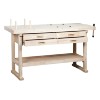socalbeachbum
Member
hope I'm not too far off topic here, but have decided to start reloading and realized I need to buy or build a good strong bench. I'd like to keep it simple stupid, keep it relatively compact.
Any good ideas for me? I've considered making it from 3/4" plywood, have thought about all 2x8 construction. Don't want something flimsy. Would about 24 x 60" be big enough? What height works out well?
Reloading .38's only initially but figure I ought to make it nice enough to handle .50 BMG if need be.
Any good ideas for me? I've considered making it from 3/4" plywood, have thought about all 2x8 construction. Don't want something flimsy. Would about 24 x 60" be big enough? What height works out well?
Reloading .38's only initially but figure I ought to make it nice enough to handle .50 BMG if need be.



![20140628_115702[1].jpg](/data/attachments/146/146189-74b0cc1f149dca79284bf7fa75f80613.jpg)



